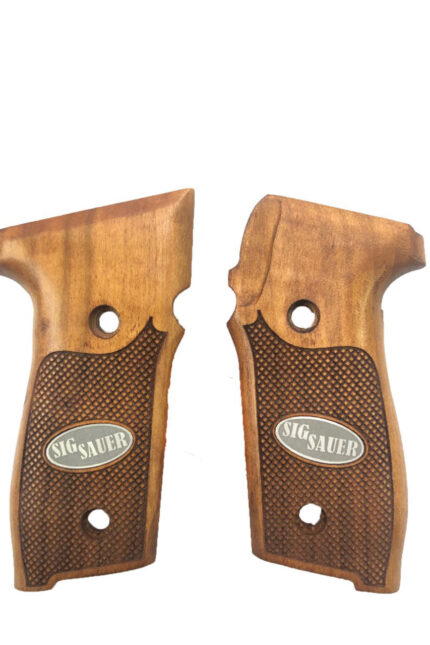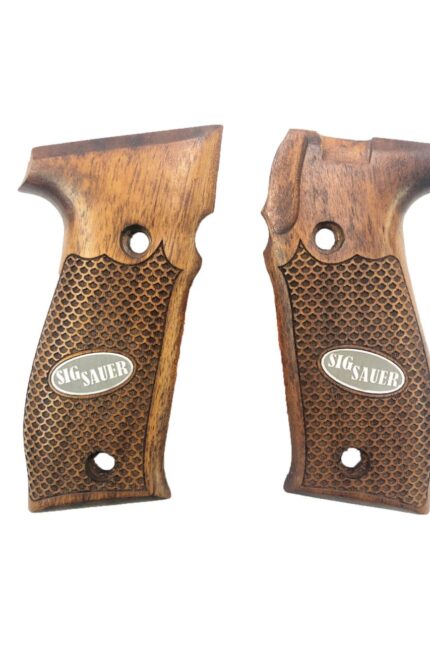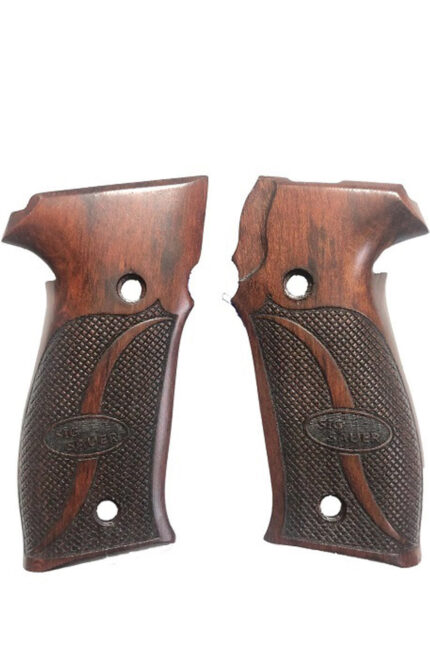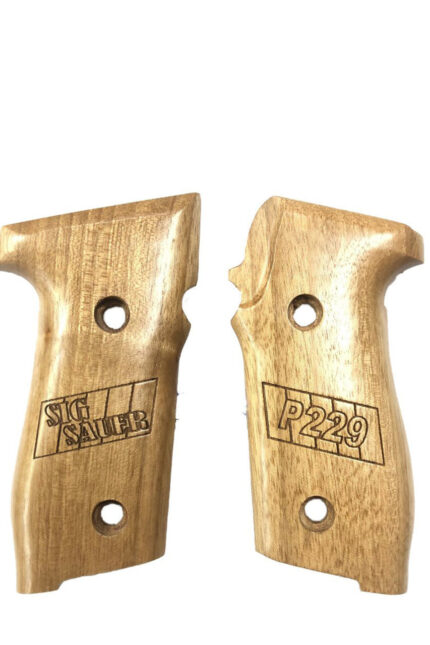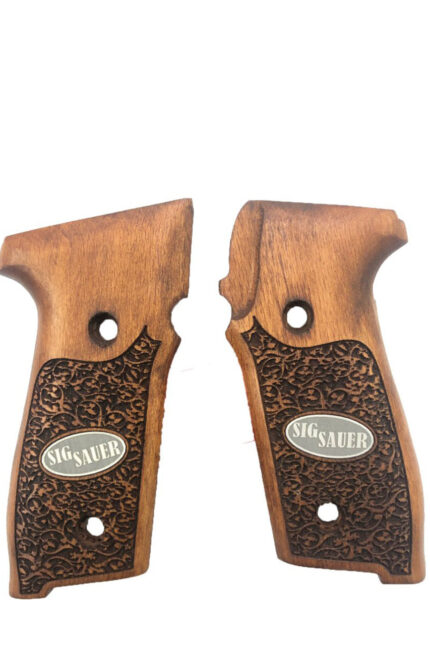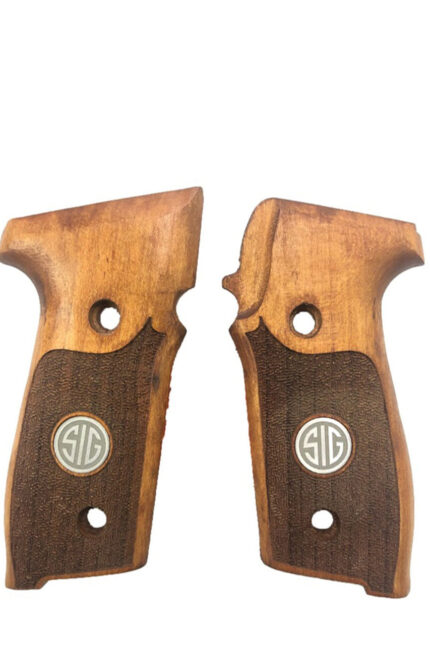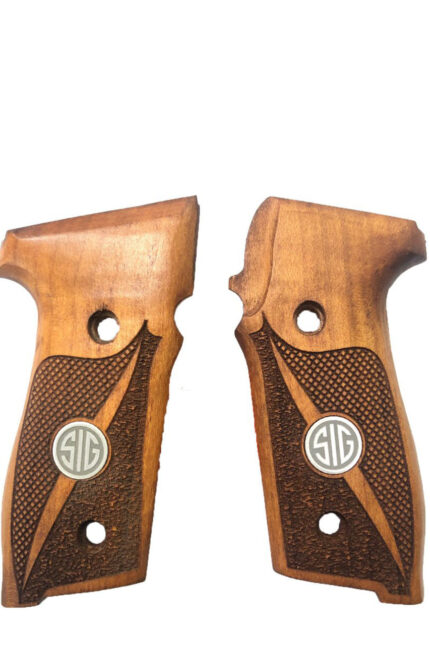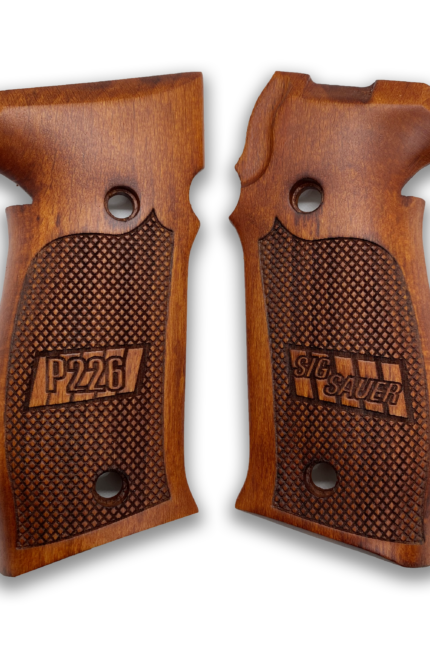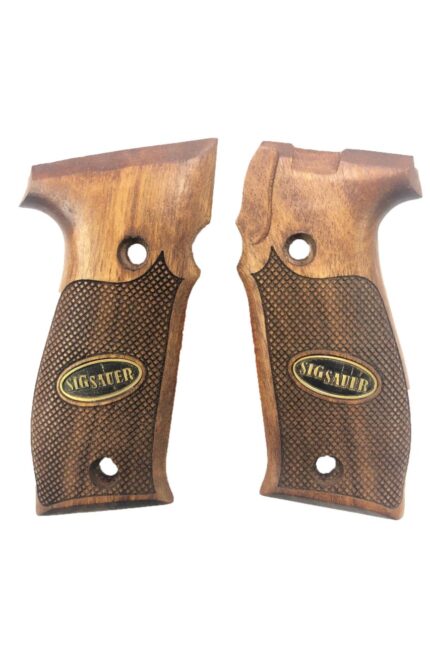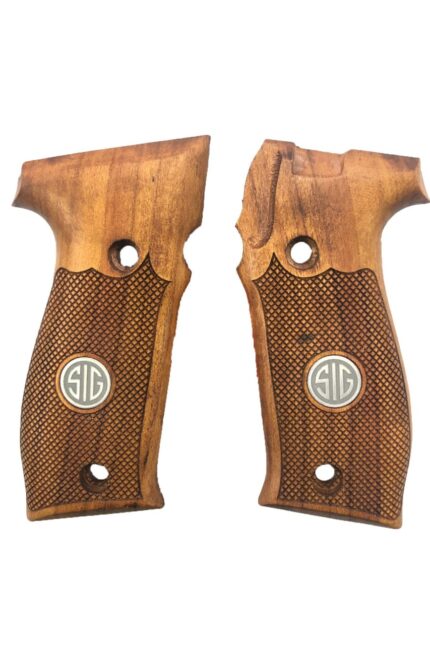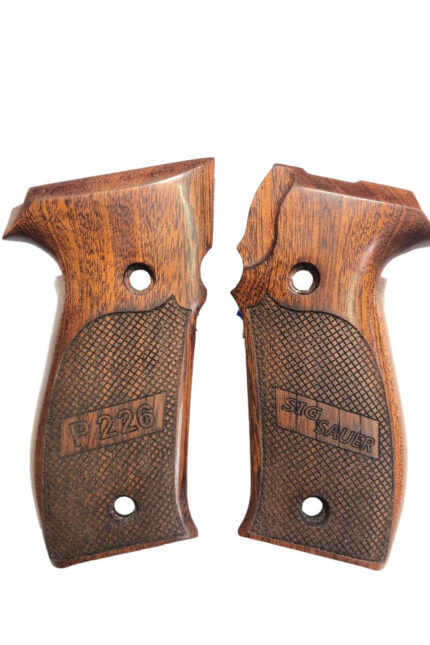Showing 1–12 of 41 results
Categories
Compatible Models
Color
- Natural Wood 25
Material
- Beech wood 25
Logo
- Without Logo 25
Laser Engraver
- Yes 25
Heat Treated
- Yes 25
Load more products
Loading...
Introduction to Ideal Shooting Techniques with Sig Sauer
Sig Sauer is synonymous with precision and reliability, qualities that are crucial for both tactical operators and shooting enthusiasts alike. This guide is designed to enhance your shooting techniques by harnessing the full potential of your Sig Sauer firearm. We will delve into a series of fundamental and advanced shooting practices that are tailored to improve accuracy, speed, and effectiveness. From mastering the basics of stance and grip to exploring dynamic shooting drills and stress-response techniques, this article will provide you with actionable insights to refine your skills. Whether you are preparing for competitive shooting, enhancing your tactical training, or simply aiming to become a more proficient shooter, these techniques will leverage the engineering excellence of Sig Sauer to elevate your performance. Join us as we explore how to transform standard shooting practices into a precision art form with Sig Sauer.
Basic Shooting Principles with Sig Sauer
Mastering the basics is the first step to proficiency with any firearm, especially with a high-performance line like Sig Sauer. This section will cover the foundational techniques of stance, grip, and trigger control, essential for achieving accurate and consistent shots.
Proper Stance and Grip Techniques
A stable stance and a firm grip are crucial for effective shooting with a Sig Sauer:
- Stance: Adopt a balanced and comfortable stance that allows for both stability and mobility. Whether you prefer the isosceles or Weaver stance, ensure your body is aligned with the target for optimal support.
- Grip: Utilizing Sig Sauer grips, including Sig Sauer wooden grips for those who prefer a traditional feel, can significantly affect control and recoil management. Ensure your grip is firm but not tense, with thumbs positioned correctly to avoid interference with slide operation.
Breath Control and Trigger Mechanics
Breath control and trigger discipline are key to precision:
- Breath Control: Learn to manage your breathing to minimize involuntary movement. Inhale deeply and exhale partially before holding your breath at the moment you ready to fire, providing a moment of stillness for precision.
- Trigger Mechanics: Employ a smooth, consistent trigger pull. Using the best Sig Sauer custom grips can enhance the ergonomic interaction with the trigger, allowing for a cleaner pull and release. Focus on pulling straight back with just the pad of your index finger, without disturbing the aim.
Understanding Sig Sauer's Trigger System
Sig Sauer's trigger systems are designed for responsiveness and reliability:
- Trigger System Features: Get familiar with the specific characteristics of your Sig Sauer's trigger system. Whether it's a traditional DA/SA, a striker-fired mechanism, or Sig's DAK (Double Action Kellerman) system, understanding how it operates will aid in mastering trigger control.
- Practice Drills: Incorporate dry fire drills into your routine to get accustomed to the trigger's feel and reset point. This practice is invaluable for developing muscle memory and enhancing reaction time.
Target Focusing Strategies
Effective targeting is not just about aiming but also how quickly and accurately you can engage with a target. This section covers techniques to refine your focus and improve your targeting speed using a Sig Sauer.
Rapid Target Acquisition and Transition Techniques
Speed and accuracy in acquiring targets are vital for dynamic shooting environments:
- Quick Sight Alignment: Practice aligning your sights as quickly as possible. With Sig Sauer's clear and intuitive sight design, including options like enhanced Sig Sauer custom grips, which stabilize the firearm during rapid movements, you can achieve faster sight picture recognition.
- Transition Drills: Work on drills that help you move swiftly between multiple targets. Effective transitioning requires not only quick sight realignment but also controlled movements to maintain accuracy. Practice shooting at varying distances and angles to develop a versatile skill set.
Long-Distance Shooting Tips
Long-range shooting with a Sig Sauer demands precision and an understanding of external factors:
- Understanding Ballistics: Get to know the ballistics of the ammunition you use in your Sig Sauer. Factors like bullet drop and wind drift play a significant role in long-distance accuracy.
- Stable Platform: Utilize a stable shooting platform and maintain a consistent shooter's triangle (formed by the arms and chest) to support your Sig Sauer during long shots. Enhancements like specialized Sig Sauer grips can also aid in reducing fatigue and improving stability over extended periods.
Using Technology to Aid Targeting
Incorporate modern technology to further enhance your targeting capabilities:
- Laser Sights and Rangefinders: Equip your Sig Sauer with laser sights for quick targeting in low visibility conditions, or use rangefinders to accurately gauge distances in open range scenarios.
- Optics: Consider scopes and red-dot sights that can be mounted on your Sig Sauer to improve accuracy at distance. Ensure that these accessories are compatible with your firearm model for optimal functionality.
Evaluating Performance
Regularly assess your targeting techniques and the effectiveness of your practices:
- Record Keeping: Keep a log of your shooting sessions to track progress and identify areas for improvement. Note factors like distance, target sizes, environmental conditions, and the accessories used, such as different types of Sig Sauer wooden grips.
- Feedback and Adjustment: Use feedback from instructors or experienced shooters to fine-tune your techniques. Adjust your training regimen based on performance data and continue practicing with various targeting scenarios.
Advanced Shooting Tactics for Sig Sauer
Advanced tactics can significantly enhance your proficiency with a Sig Sauer, enabling you to handle challenging scenarios with greater skill and confidence. We will cover key areas such as engaging multiple targets effectively and maintaining composure under pressure.
Engaging Multiple Targets
Effective engagement of multiple targets requires not only speed but also strategic planning:
- Sequential Targeting: Learn to prioritize targets based on threat level or competitive requirements. Develop a methodical approach to engaging targets in a sequence that minimizes time and movement.
- Sweep vs. Stacking: Understand when to use sweeping techniques (moving the gun in a horizontal or vertical line) versus stacking (shooting closest to farthest or vice versa) based on the layout and distances of targets. This decision-making process is crucial for tactical shooting and timed competitions.
Shooting Under Stress
Performing under stress is critical for defense scenarios and competitive shooting:
- Controlled Breathing: Master the art of controlling your breathing under stress to maintain a steady aim. Techniques such as the combat breathing method, which involves deep, controlled breaths, can help stabilize your heart rate and improve focus.
- Drill Under Simulated Stress: Practice shooting drills that simulate stress conditions, such as timed drills, drills with physical barriers, or while wearing full gear. This can help acclimate you to the physiological and psychological effects of high-pressure situations.
Tactical Movement and Cover Usage
Incorporate movement and cover into your shooting practices to mimic real-world conditions:
- Use of Cover: Train to use environmental cover effectively when shooting. Learn how to quickly identify and move to cover, and practice firing from protected positions.
- Shooting on the Move: Develop the ability to shoot accurately while moving. This skill is essential for tactical applications where static shooting is not feasible. Techniques include shooting while advancing, retreating, and lateral movement.
Mental Preparation and Scenario-Based Training
Mental toughness and scenario-based preparation can dramatically improve your shooting performance:
- Mental Rehearsal: Engage in mental rehearsal before live practice or competitions. Visualize different shooting scenarios and your responses to them, which can enhance decision-making speed during actual firing.
- Realistic Scenarios: Set up training exercises that mimic potential real-life situations. Use targets at varied distances and configurations to replicate potential threats or competition setups. This approach helps in adapting your tactics to different challenges.
Daily Practice Routines and Tips
Consistent practice is key to maintaining proficiency with your Sig Sauer. This section outlines effective daily routines and practice tips that help reinforce the skills and tactics previously discussed.
Effective Training Programs
Developing a structured training program is crucial for systematic improvement:
- Regular Dry Firing: Incorporate dry firing into your daily routine to refine trigger control and aiming without the need for live ammunition. This is an effective, cost-efficient way to practice, especially with specialized Sig Sauer custom grips that enhance the feel and handling of your firearm.
- Skill-Specific Drills: Design drills that focus on specific skills such as reloading, drawing from a holster, or transitioning between targets. These drills help build muscle memory and increase your efficiency and speed with a Sig Sauer.
Accessories to Enhance Performance
Select accessories that complement your training and improve your shooting experience:
- Use of Sights and Scopes: For precision practice, equip your Sig Sauer with sights and scopes that suit your shooting style and the scenarios you train for. Experiment with different types of sights to find what best improves your accuracy and targeting speed.
- Customization with Grips and Stocks: Consider using best Sig Sauer custom grips and adjustable stocks to enhance the ergonomics of your firearm. Custom grips can significantly change the feel of your gun, providing better control and comfort during extended training sessions.
Incorporating Feedback and Analysis
Continuous improvement involves regular evaluation and adaptation:
- Video Analysis: Record your practice sessions to visually critique your stance, grip, and shooting technique. Video analysis can be an eye-opening way to see areas for improvement that are not always noticeable in the moment.
- Instructor Feedback: If possible, work with a shooting coach or experienced instructor who can provide direct feedback and suggest adjustments to refine your techniques.
Maintenance and Cleaning Post-Practice
Proper post-practice care ensures your Sig Sauer remains in excellent condition:
- Routine Cleaning: After each practice session, thoroughly clean your Sig Sauer to remove residues and deposits. This prevents build-up that could affect the firearm’s performance and longevity.
- Functional Checks: Regularly check the function of all moving parts and safety features to ensure everything is working as it should. This is crucial after modifications or prolonged use.
Throughout this guide, we've explored a range of essential techniques and strategies for optimizing your Sig Sauer, from basic shooting fundamentals and advanced tactical maneuvers to comprehensive maintenance routines and effective training programs. Each section was designed to enhance your understanding and proficiency with Sig Sauer firearms, ensuring you can fully leverage their renowned reliability and performance, whether for personal defense, competitive shooting, or recreational purposes.
As you continue to explore the capabilities of your Sig Sauer and seek to customize and maintain your firearm, remember that zibgrips.com is your premier resource for high-quality accessories and expert advice. Our extensive selection of custom grips, sights, and other enhancements is tailored to meet the needs of discerning shooters looking to elevate their firearm's performance and aesthetics. Visit zibgrips.com today to discover products that will transform your Sig Sauer into a perfectly tuned extension of your shooting ambition.
At zibgrips.com, we're committed to providing you with the tools and resources needed to achieve excellence in every shot. Let us help you turn your Sig Sauer into the ultimate firearm for your needs. Connect with us for personalized recommendations and start your journey toward shooting perfection.
What are 1911 Grips: Their Importance for Your Firearm
Understanding the Role of 1911 Grips in Firearm Ergonomics
1911 grips are more than just a part of your handgun; they are crucial for ensuring optimal control and stability during use. These grips, often made from a variety of materials, including the popular 1911 wooden grips, allow for a better grasp and significantly reduce the risk of slippage. Whether you're using your firearm for competitive shooting or self-defense, the right grips can enhance both performance and comfort.
The Aesthetic Impact of 1911 Grips on Your Firearm
Besides functionality, 1911 grips also play a pivotal role in customizing the appearance of your firearm. With best 1911 custom grips, gun owners have the opportunity to personalize their weapon to reflect their style and preferences. This customization not only makes your firearm more unique but also can increase its overall value.
In summary, 1911 grips are essential for both the functional ergonomics and aesthetic customization of your firearm. Choosing the right type of grip, such as the 1911 wooden grips, can transform the shooting experience by providing both a secure hold and a personal touch to your firearm.
Benefits of Custom 1911 Grips
Enhanced Shooting Accuracy with Custom Grips
Customizing your 1911 grips not only elevates the look of your firearm but also enhances your shooting accuracy. Tailored grips fit perfectly into the palm of your hand, allowing for more precise control over the firearm. This precision is particularly crucial during competitive shooting or high-stress situations where every millisecond counts.
Improved Comfort and Reduced Fatigue
Another significant advantage of using best 1911 custom grips is the improved comfort they provide. Custom grips are designed to align with the natural contours of your hands, reducing the strain on your fingers and wrist during prolonged use. This ergonomic benefit helps in minimizing fatigue and maintaining a steady hand for longer periods.
Durability and Longevity of Materials
Choosing high-quality materials for your 1911 grips can greatly increase the durability and longevity of your firearm. Materials like premium wood or advanced polymers are not only robust but also resistant to environmental factors such as moisture and temperature changes. Investing in 1911 wooden grips made from superior materials ensures that your firearm remains reliable and functional over time.
In conclusion, the benefits of customizing your 1911 grips extend far beyond aesthetics. They contribute to a more accurate, comfortable, and durable shooting experience, making them an essential consideration for any firearm enthusiast.
Best Materials for 1911 Grips
Exploring Popular Materials for Enhanced Performance
When it comes to customizing 1911 grips, the choice of material can significantly affect both the functionality and aesthetics of your firearm. Some of the most popular materials include wood, synthetic polymers, and metals. Each material offers distinct advantages, such as the warmth and classic beauty of 1911 wooden grips that appeal to traditionalists and collectors alike.
The Benefits of Wooden Grips
Wood is prized for its natural texture and the ability to carve intricate designs into it. High-quality woods like walnut or mahogany not only enhance the visual appeal but also provide a durable grip that ages gracefully with your firearm. These 1911 wooden grips are perfect for those who value craftsmanship and a timeless look.
Synthetic and Composite Materials: Modern Alternatives
Synthetic grips, made from materials like G10 or rubber, offer modern shooters a variety of textures and colors. These materials are engineered to withstand harsh conditions without deteriorating, making them ideal for tactical use. They also tend to be lighter than metal or wood, which can help reduce the overall weight of the firearm.
Metal Grips for Durability and Precision
Metal grips, often crafted from aluminum or stainless steel, offer unmatched durability and a sleek, modern aesthetic. They are especially favored in competitive shooting for their ability to add heft and stability to the firearm, aiding in recoil management and improving shot consistency.
Choosing the right material for your 1911 grips is crucial in enhancing both the performance and appearance of your firearm. Whether you prefer the classic elegance of wood, the resilience of synthetics, or the modern touch of metal, each material provides unique benefits that cater to different shooting styles and preferences.
Considerations When Choosing 1911 Grips
Assessing Grip Size and Hand Fit
One of the most crucial factors to consider when selecting 1911 grips is how well they fit in your hand. Not all hands are the same size or shape, and choosing a grip that complements your hand's unique characteristics can greatly enhance control and comfort. It's important to try different sizes and shapes to see what feels most natural and provides the best support during shooting.
Style and Personal Preference
While functionality is key, the style of the grip should also reflect your personal taste. Whether you prefer the classic look of 1911 wooden grips or the more modern appeal of tactical synthetics, the appearance of your grips can significantly enhance your firearm's overall aesthetic. Remember, the style you choose not only affects how you feel about your weapon but can also influence your confidence and performance.
Environmental Considerations
The environment in which you use your firearm also plays a significant role in choosing the right grips. For those frequently exposed to wet conditions, materials that provide better grip even when wet, like rubber or textured polymers, might be ideal. Conversely, if you're often in dusty or sandy environments, you might prefer grips that are easy to clean and maintain.
Long-Term Durability and Maintenance
Finally, consider the durability and maintenance requirements of different grip materials. Some materials, like high-quality woods and metals, might require more care to maintain their appearance and functionality over time. Synthetic materials often offer ease of maintenance but check for quality to ensure they can withstand years of use without degrading.
1911 grips involves a careful balance of functional fit, aesthetic preference, environmental suitability, and long-term durability. By considering these aspects, you can select grips that not only improve the performance and look of your firearm but also cater to your specific needs and conditions.
Installing 1911 Grips: A Step-by-Step Guide
Preparing Your Firearm for Installation
Before beginning the installation of your 1911 grips, it is crucial to ensure that your firearm is unloaded and safe to handle. Check the chamber and the magazine to make sure they are both clear. Once safety is confirmed, you can proceed with disassembling the necessary parts of your firearm to replace the grips.
Tools Needed for Grip Installation
To install new grips on your 1911, you will typically need a few basic tools: a screwdriver that fits the grip screws, possibly an Allen wrench depending on the grip design, and a small hammer for any adjustments. Having the right tools at hand will make the installation process smoother and prevent damage to your new grips or firearm.
Step-by-Step Installation Process
- Remove the Old Grips: Using the appropriate screwdriver, remove the screws from the current grips. Carefully lift the grips away from the frame, being mindful of any washers or small parts.
- Clean the Grip Area: With the old grips removed, clean any debris or buildup from the grip area. This ensures a clean contact surface for the new grips, which can improve fit and prevent slippage.
- Align the New Grips: Place your new 1911 grips onto the frame. Ensure that all holes and cutouts align properly with the mounting points and controls on the firearm.
- Secure the Grips: Attach the new grips using the screws you removed earlier or new ones if provided. Tighten the screws evenly but do not over-tighten, as this could damage the grips or the firearm's frame.
- Check Functionality: Once the grips are installed, reassemble your firearm and perform a function check to ensure that all parts are working correctly and that the grips are securely attached.
Post-Installation Tips
After installing your new grips, it's a good idea to spend some time handling your firearm to get accustomed to the feel of the new material and shape. If any adjustments are needed, it's better to address these sooner rather than later to ensure optimal comfort and functionality.
Installing 1911 grips is a straightforward process that can significantly enhance the handling and aesthetics of your firearm. With the right tools and careful attention to detail, you can successfully customize your 1911 to better meet your shooting needs and personal style.
Frequently Asked Questions and Answers
Can I install 1911 grips on my own, or should I have a professional do it?
Installing 1911 grips can generally be done by most firearm owners using basic tools. As outlined in the previous guide, with the right tools and careful attention, you can install your grips at home. However, if you are not confident in your ability to safely handle your firearm, it is advisable to seek professional help.
How often should I replace my 1911 grips?
The frequency of replacing your grips depends on the material and how extensively you use your firearm. 1911 wooden grips, for example, may last many years with proper care. Regular inspections for wear and tear can help you determine when a replacement is necessary.
Are there any legal considerations for customizing grips?
In most regions, customizing grips is legally permissible as it does not alter the fundamental mechanics of the firearm. However, it is always best to check local laws and regulations to ensure compliance.
How do I choose the best material for my 1911 grips?
As discussed in earlier sections, the best material for your 1911 grips will depend on your specific needs and preferences. Consider factors like durability, comfort, aesthetic preference, and environmental conditions when choosing grip materials.
Can changing grips affect the resale value of my firearm?
Yes, changing grips can affect your firearm's resale value. High-quality, well-maintained grips, especially custom or designer ones, can increase the value, while poor-quality grips might decrease it. Always choose grips that enhance both the functionality and appearance of your 1911.
Throughout this comprehensive guide on 1911 grips, we've explored various aspects from their crucial role in enhancing firearm control and aesthetics to the detailed steps involved in selecting and installing them. Custom 1911 grips not only improve the functionality and appearance of your firearm but also offer an opportunity to express personal style and preference.
By understanding the importance of material choice, fitting the grip to your hand, and the aesthetic impact, you can significantly enhance your shooting experience. Remember, whether you opt for the classic elegance of 1911 wooden grips or the modern resilience of synthetic options, each choice plays a pivotal role in your firearm's performance and your satisfaction as an owner.
For those interested in exploring a wide range of custom grip options, or if you require assistance in choosing the right grips for your 1911, visit 1911 pistol grips. Here, you can find expert advice and a curated selection of high-quality grips designed to meet the needs of both casual shooters and competitive marksmen alike. For bulk purchases or more detailed inquiries, feel free to contact us via email at [email protected] or call our support line at +1 917 565 83 06.
Enhance your firearm today with the perfect set of 1911 grips and experience the difference in control, comfort, and customization.

